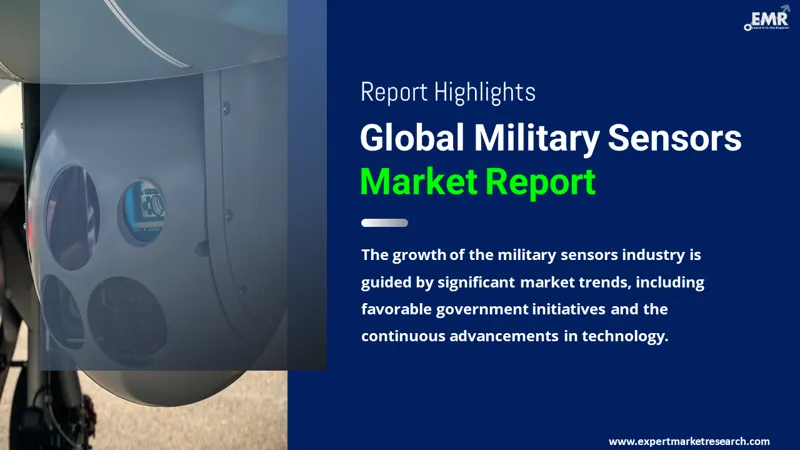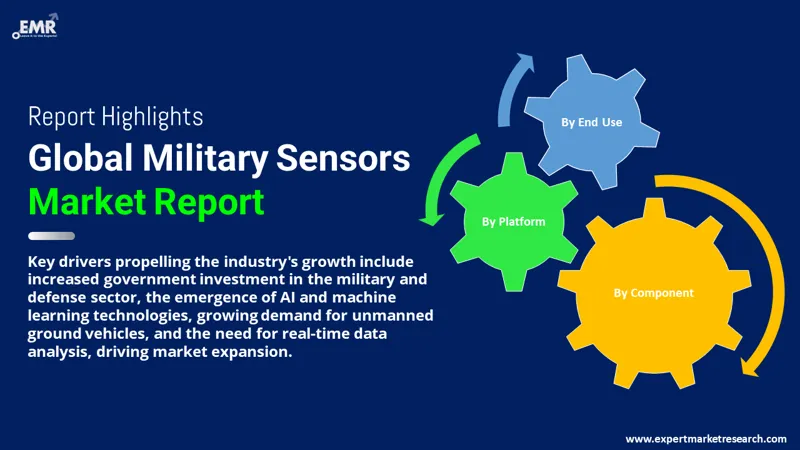
Consumer Insights
Uncover trends and behaviors shaping consumer choices today
Procurement Insights
Optimize your sourcing strategy with key market data
Industry Stats
Stay ahead with the latest trends and market analysis.
The global military sensors market reached a value of around USD 12.65 Billion in 2025. The industry is further projected to grow at a CAGR of 5.80% between 2026 and 2035.
Base Year
Historical Period
Forecast Period
Compound Annual Growth Rate
5.8%
Value in USD Billion
2026-2035
*this image is indicative*
The rapid development of defence systems by military forces and the continued military modernisation programmes in separate nations are some of the variables anticipated to boost the development of the military sensors industry over the forecast period.

Read more about this report - REQUEST FREE SAMPLE COPY IN PDF
The global military sensors market can be divided based on segments like component, platform, and end-use.
The industry, based on its component, is divided into:
The military sensors market can be divided based on its platform into:
The industry can be broadly categorised based on its end-uses into:
Looks into the regional military sensors markets like:

Read more about this report - REQUEST FREE SAMPLE COPY IN PDF
The increasing demand for real-time data processing and analysis through artificial intelligence and machine learning is anticipated to drive the development of the military sensors market, especially its software segment. The land segment growth can be ascribed to the enhanced demand for unmanned ground vehicles in the defence sector. The electronic warfare segment is expected to develop at the highest CAGR between 2021 and 2026.
Countries like the United States, China, and India are purchasing military aircrafts, which is aiding the overall market growth. Further, the Asia Pacific market is expected to witness the fastest growth rate driven by the rapidly emerging economies within the region.
The report presents a detailed analysis of the following key players in the global military sensors market, looking into their capacity, market shares, and latest developments like capacity expansions, plant turnarounds, and mergers and acquisitions:
The EMR report gives an in-depth insight into the military sensors market by providing a SWOT analysis as well as an analysis of Porter’s Five Forces model.




*While we strive to always give you current and accurate information, the numbers depicted on the website are indicative and may differ from the actual numbers in the main report. At Expert Market Research, we aim to bring you the latest insights and trends in the market. Using our analyses and forecasts, stakeholders can understand the market dynamics, navigate challenges, and capitalize on opportunities to make data-driven strategic decisions.*
Get in touch with us for a customized solution tailored to your unique requirements and save upto 35%!
In 2025, the global military sensors market attained a value of nearly USD 12.65 Billion.
The market is projected to grow at a CAGR of 5.80% between 2026 and 2035.
The key trends guiding the growth of the market include the growing investments in the military and defence sector by various governments, the advent of AI and machine learning, the rising demand for unmanned ground vehicles, and the need for real-time data analysis.
The key trends guiding the growth of the market include the introduction of favourable government initiatives and technological advancements.
The major regions in the market are North America, Latin America, the Middle East and Africa, Europe, and the Asia Pacific.
Hardware, software, and cybersecurity solutions are the major components of military sensors.
Airborne, land, naval, space, and munitions are the significant platforms of military sensors considered in the market report.
The major end use segments of the product include intelligence and reconnaissance, communication and navigation, combat operations, electronic warfare, target recognition, surveillance and monitoring, artillery systems, and command and control.
The major players in the market are Honeywell International Inc, TE Connectivity Ltd., Raytheon Technologies Corporation, Lockheed Martin Corporation, Thales Group, Kongsberg Gruppen ASA, Ultra Electronics, Esterline Technologies Corporation, General Electric Company, BAE Systems PLC, Microflown Avisa B.V., and Vectornav Technologies, LLC, among others.
Explore our key highlights of the report and gain a concise overview of key findings, trends, and actionable insights that will empower your strategic decisions.
| REPORT FEATURES | DETAILS |
| Base Year | 2025 |
| Historical Period | 2019-2025 |
| Forecast Period | 2026-2035 |
| Scope of the Report |
Historical and Forecast Trends, Industry Drivers and Constraints, Historical and Forecast Market Analysis by Segment:
|
| Breakup by Component |
|
| Breakup by Platform |
|
| Breakup by End Use |
|
| Breakup by Region |
|
| Market Dynamics |
|
| Competitive Landscape |
|
| Companies Covered |
|
| Report Price and Purchase Option | Explore our purchase options that are best suited to your resources and industry needs. |
| Delivery Format | Delivered as an attached PDF and Excel through email, with an option of receiving an editable PPT, according to the purchase option. |
Datasheet
One User
USD 2,499
USD 2,249
tax inclusive*
Single User License
One User
USD 3,999
USD 3,599
tax inclusive*
Five User License
Five User
USD 4,999
USD 4,249
tax inclusive*
Corporate License
Unlimited Users
USD 5,999
USD 5,099
tax inclusive*
*Please note that the prices mentioned below are starting prices for each bundle type. Kindly contact our team for further details.*
Flash Bundle
Small Business Bundle
Growth Bundle
Enterprise Bundle
*Please note that the prices mentioned below are starting prices for each bundle type. Kindly contact our team for further details.*
Flash Bundle
Number of Reports: 3
20%
tax inclusive*
Small Business Bundle
Number of Reports: 5
25%
tax inclusive*
Growth Bundle
Number of Reports: 8
30%
tax inclusive*
Enterprise Bundle
Number of Reports: 10
35%
tax inclusive*
How To Order

Select License Type
Choose the right license for your needs and access rights.

Click on ‘Buy Now’
Add the report to your cart with one click and proceed to register.

Select Mode of Payment
Choose a payment option for a secure checkout. You will be redirected accordingly.
Gain insights to stay ahead and seize opportunities.

Get insights & trends for a competitive edge.

Track prices with detailed trend reports.

Analyse trade data for supply chain insights.

Leverage cost reports for smart savings

Enhance supply chain with partnerships.

Connect For More Information
Our expert team of analysts will offer full support and resolve any queries regarding the report, before and after the purchase.
Our expert team of analysts will offer full support and resolve any queries regarding the report, before and after the purchase.
We employ meticulous research methods, blending advanced analytics and expert insights to deliver accurate, actionable industry intelligence, staying ahead of competitors.
Our skilled analysts offer unparalleled competitive advantage with detailed insights on current and emerging markets, ensuring your strategic edge.
We offer an in-depth yet simplified presentation of industry insights and analysis to meet your specific requirements effectively.
Share